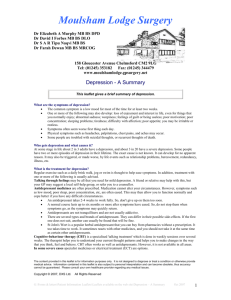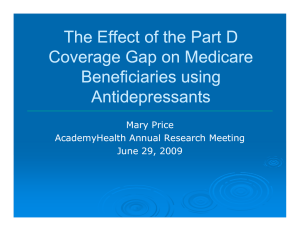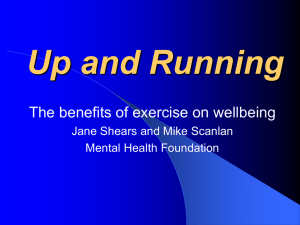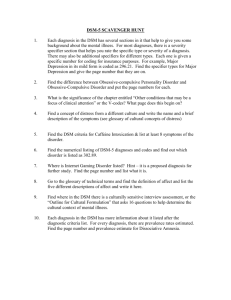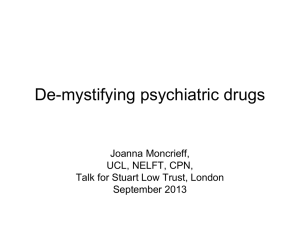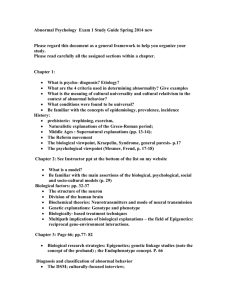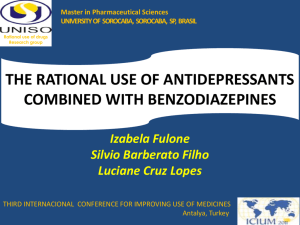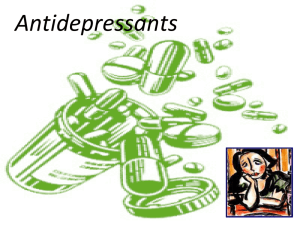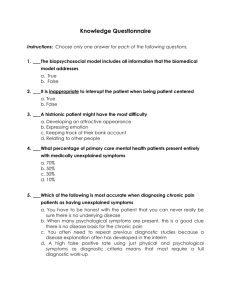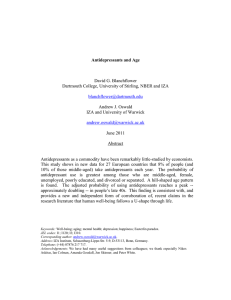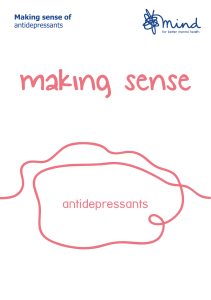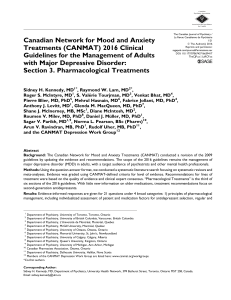Depression - Primrose Unit
advertisement
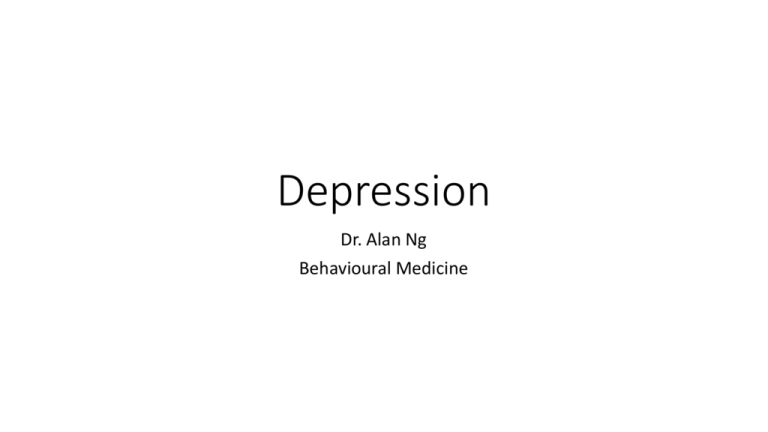
Depression Dr. Alan Ng Behavioural Medicine Reference Psychiatry in Primary Care Editors: Goldbloom, Davine CAMH, Toronto 2011 Objectives • Discuss the differential diagnosis of depression • How to screen for depression • Discuss the DSM V criteria for major depression episode • Discuss a strategy for psychopharmacology/use of antidepressants • What is reasonable to expect from a primary care physician in managing depression? • When should you refer to a specialist? What is the differential diagnosis of depression? What is the differential diagnosis of depression? • Organic conditions Generally guided by history and examination Screening bloodwork should normally be CBC (rule out anemia) and TSH unless otherwise indicated • ETOH/substance abuse • medications What is the differential diagnosis of depression? • Grief and major psychosocial stressors (adjustment disorder) • Bipolar disorder • Anxiety disorder • Personality disorder (especially cluster B) How to make the diagnosis in less than five minutes How to make the diagnosis in less than five minutes Screening questions (quick screen) 1. In the past month, have you lost interest or pleasure in things you normally like to do? 2. Have you felt sad, low, down, depressed or hopeless? If answer ‘yes’ to either question, consider further exploration/assessment What are risk factors for Major Depressive Episode (MDE)? What are risk factors for Major Depressive Episode (MDE)? • Chronic insomnia or fatigue • Unexplained somatic symptoms • Chronic medical illness • Recent cardiovascular event (CVA,MI) • Recent trauma (psychological or physical) • Other psychiatric disorder • Family history of mood disorder • Extensive use of medical system (‘thick chart syndrome’) What tools are available to make the diagnosis? What tools are available to make the diagnosis? • SIGECAPS • PHQ-9 • Mood Disorder Questionnaire What is the DSM V criteria for major depressive episode? What is the DSM V criteria for major depressive episode? A. • Five (or more) of the following symptoms have been present during the same 2- week period and represent a change from previous functioning; • at least one of the symptoms is either (1) depressed mood or (2) loss of interest or pleasure. Do not include symptoms that are clearly due to a general medical condition, or mood-incongruent delusions or hallucinations. What is the DSM V criteria for major depressive episode? • Depressed mood most of the day, nearly every day, as indicated by either subjective report (e.g., feels sad or empty) or observation made by others (e.g., appears tearful). Note: In children and adolescents, can be irritable mood. • Markedly diminished interest or pleasure in all, or almost all, activities most of the day, nearly every day (as indicated by either subjective account or observation made by others). • Significant weight loss when not dieting or weight gain (e.g., a change of more than 5 percent of body weight in a month), or decrease or increase in appetite nearly every day. Note: In children, consider failure to make expected weight gains. • Insomnia or hypersomnia nearly every day. DSM V criteria for MDE • Psychomotor agitation or retardation nearly every day (observable by others, not merely subjective feelings of restlessness or being slowed down). • Fatigue or loss of energy nearly every day. • Feelings of worthlessness or excessive or inappropriate guilt (which may be delusional) nearly every day (not merely self-reproach or guilt about being sick). • Diminished ability to think or concentrate, or indecisiveness, nearly every day (either by subjective account or as observed by others). • Recurrent thoughts of death (not just fear of dying), recurrent suicidal ideation without a specific plan, or a suicide attempt or a specific plan for committing suicide DSM criteria for MDE B. The symptoms cause clinically significant distress or impairment in social, occupational or other important areas of functioning. C. The symptoms are not due to the direct physiological effects of a substance (e.g., a drug of abuse, a medication) or a general medical condition (e.g., hypothyroidism). Source: DSM-V, American Psychiatric Association Psychopharmacology What is the goal of acute treatment? Psychopharmacology What is the goal of acute treatment? • Full remission of symptoms • Return to baseline function • Can evaluate using PHQ-9, Beck, Hamilton rating scales How do you decide how to choose an antidepressant? How do you decide how to choose an antidepressant? • There is no one definite choice as it depends on individual variability between efficacy and side effects • Some evidence for increased efficacy with ecitalopram, mirtazepine and venlafaxine with severely depressed patients • Some evidence for short-term tolerability with citalopram, escitalopram, moclobemide, sertraline How do you decide how to choose an antidepressant? • Broad spectrum agent (for both anxiety and depression) recommended due to high comorbidity for both disorders Eg escitalopram, paroxetine, sertraline, venlafaxine (others may also be effective for anxiety disorders but studies have not been done) • Bupropion, mirtazepine and moclobamide have fewer sexual side effects First line antidepressants • What would you choose as first line antidepressant? First line antidepressants • SSRI-selective serotonin reuptake inhibitors • SNRI-serotonin and norepinephrine reuptake inhibitors • Novel action • RIMA-reversible monoamine oxidase inhibitor SSRI (CAMH 2011) SSRI Usual daily dose (mg) citalopram 20-40 escitalopram 10-20 fluoxetine 20-40 fluvoxamine 100-200 paroxetine 20-40 sertraline 50-150 efficacy tolerability anxiety + + + + + + + Efficacy-based upon meta-analyses and head to head trials Tolerability-based upon meta-analyses Anxiety-based on Canadian Anxiety Disorder Treatment Guidelines 2006 + SNRI SNRI Usual daily dose (mg) efficacy tolerability desvenlafaxine 50-100 duloxetine 60-120 +/- Venlafaxine-XR 75-225 + SNRI=serotonin and norepinephrine reuptake inhibitor anxiety + Novel action Novel action Usual daily dose (mg) Efficacy Tolerability Bupropion-SR 150-300 +/- mirtazepine 30-60 +/- trazodone 200-400 Anxiety RIMA RIMA Usual daily dose (mg) moclobamide 450-600 efficacy RIMA=reversible monoamine oxidase inhbitor tolerability + anxiety What are the second line antidepressants? Second line antidepressants TCA amitryptyline 100-250 clomipramine 100-250 desipramine 100-250 imipramine 100-250 nortryptyline 75-150 TCA-tricyclic antidepressants What are the third line antidepressants? Third line antidepressant MAOI Usual daily dose (mg) phenelzine 30-75 tranylcypromine 20-60 MAOI: Monaoamine oxidase inhibitor Maintenance treatment • What are the goals? • How long should you continue if patient has no risk factors? • How long should you continue if patient has risk factors? Maintenance treatment • What are the goals? • How long should you continue if patient has no risk factors? • How long should you continue if patient has risk factors? Risk factors: chronic, recurrent, severe or difficult to treat episodes Maintenance treatment • What are the goals? • How long should you continue if patient has no risk factors? • How long should you continue if patient has risk factors? • Prevention of relapse and recurrent • Without risk factors, 4-6 months • With risk factors, at least 2 years Stopping medication • How do you taper? • What are the common discontinuation symptoms? • Which medications are most likely and least likely to be associated with discontinuation symptoms? Stopping medication • Gradually taper, at least one week between each dose reduction FINISH mnemonic: • Flu-like symptoms • Insomnia • Nausea • Imbalance (dizziness) • Sensory disturbance (electric shocks) • Hyperarousal (agitation) Stopping medication • Discontinuation symptoms more likely with paroxetine, venlafaxine • Less likely with fluoxetine, moclobemide What do you do if there is no response to treatment? What do you do if there is no response to treatment? • Check diagnosis (?bipolar, substance abuse) • Optimize dose, increase to max for several weeks, manage sideeffects • Add psychotherapy • Switch to another antidepressant • Augment with augmenting agent • Augment with atypical antipsychotic agent • Combine with antidepressant in a different class Augmenting agents Augmenting agents • Triiodotyronine (T3) 25-50 ug/day • Lithium 600-900 mg/day Watch for increased side effect burden Atypical antipsychotics Atypical antipsychotics • Olanzepine 2.5-10 mg daily • Risperidone 0.5-3 mg daily • Quetiapine 100-300 mg daily Watch for increased side effect burden Partial response to treatment When there is partial response to treatment most clinicians would augment or combine so not to lose gains from the first antidepressant (consensus, little evidence) Is a washout period needed when switching between antidepressants? Is a washout period needed when switching between antidepressants? • Only to and from MAOIs How do you approach switching between antidepressants? How do you approach switching between antidepressants? Two Approaches 1. Start second antidepressant at low dose while tapering off the first dose Watch for side effect burden 2. If patient is sensitive to side effects, taper off the first antidepressant before starting the second What general advice will you give to a patient when starting antidepressants? What general advice will you give to a patient when starting antidepressants? • Antidepressants have a lag time of 2-3 weeks to response • Take medications daily • Side effects are usually mild and temporary • Continue on the medication for at least 6 months, otherwise the symptoms may return • Do not stop antidepressants before checking with your doctor Other treatments • Psychotherapy (CBT, problem solving therapy, analytic therapy) • Self-management-patient education/involve patient in plan/workbooks etc • Exercise • Light therapy (SAD) • ECT What is reasonable to expect from a primary care physician in treating depression? What is reasonable to expect from a primary care physician in treating depression? • Diagnose and develop a treatment plan • Assess suicide risk • Monitor response and outcome using scales (PHQ-9) • Aim for complete remission of symptoms for acute and maintenance treatment • Coach self-management and or use problem solving techniques • Manage medications-be familiar with at least two classes of antidepressants and at least one augmentation strategy • Refer when necessary When do you refer to a specialist? When do you refer to a specialist? • Complicating comorbidity (substance abuse, personality disorder, anxiety disorder) • Severe presentation (suicidality, psychosis,bipolar esp with mania) • Diagnostic clarification needed • Refractory to treatment (CBT, two or more medication trials)
